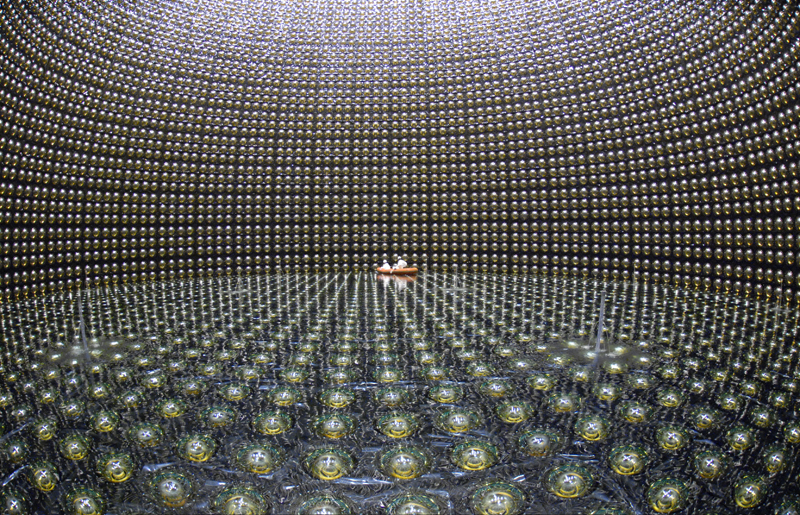The Secret Life of Neutrinos
Physicist unravels secrets of an enigmatic tiny particle
In the video above, Ed Kearns, professor of physics at the College of Arts & Sciences, discusses what neutrinos are and where they come from. Video by Devin Hahn and Joe Chan. Thumbnail by Cydney Scott
Every second, about 10 trillion neutrinos are zipping through your body. But because these ghostly particles have hardly any mass, no electric charge, and rarely interact with matter, you don’t feel a thing.
Despite their tiny size—or perhaps because of it—neutrinos may have played an outsized role in the formation and distribution of the universe. Physicist Ed Kearns was part of the team that discovered neutrino mass in 1998, and he has devoted his career to unraveling the secrets of this mysterious particle. He organized Neutrino 2014, the 26th biannual international conference on neutrino physics and astrophysics, which took place in summer 2014 at Boston University. This premier event drew hundreds of researchers from around the globe. We spoke with Kearns, professor of physics at the College of Arts & Sciences, during a break in the conference.
BU Research: Neutrinos have no electric charge, no mass…
Kearns: Hardly any mass!
OK, hardly any mass, and it’s nearly impossible to detect them. So why should we love them?
Well, they’re a part of our universe! It’s just like the quarks and electrons, all the particles in our universe, and we have to understand each and every one of them and put them in their place. They play a role in the way the universe was created, and how clumpy the universe is. We just want to know everything about everything.
How big are neutrinos? Are they really, really, smaller than a proton?
They’re really, really, smaller than a proton; really, really, smaller than an electron. They’re clearly—almost certainly—the lightest-weight particle in the universe. We measure mass in units of electron volts. It’s a funny unit. But for comparison, the mass of the electron is 511 million electron volts, maybe. The mass of the neutrino could be almost one electron volt. But it could be quite a bit lighter than that. It could be like 10-2 electron volts.
Yikes!
Yeah. So it’s very small. This mass turned into energy is just barely enough to break a bond of an atom. And it would never do that because the reaction is too weak.
That’s funny. A neutrino would never do something like that, break a bond.
No, it would never do that. Exactly.
It’s just not that kind of particle.
Right.
What attracted you to neutrinos in the first place? Why not study something bigger? Something with a little more oomph?
Something called the solar neutrino puzzle came up in the mid-seventies. Ray Davis wanted to count how many neutrinos were coming out of the sun, and he came up with a number that was far too short. And so that led to further experiments: Is the calculation wrong? Is he making a mistake in his experiment? He was counting individual atoms at the rate of one per every few days, so it was tough business. So new experiments got built. By the mid-eighties, early nineties, the thinking was still that neutrinos had zero mass. At that time I was a postdoctoral associate, and joined an experiment that could resolve if maybe they had mass.
So you can imagine this blurry picture of how neutrinos fit into things, and it’s just becoming clearer and clearer. We’re starting to see patterns and images forming. And your instinct as a human is, “I want to see what’s there!” Right? If you’re looking at a blurry image, you want to turn the knob and see: is it the Mona Lisa or your friend from down the street?
What’s left to clarify the picture? You already know they have mass. Aren’t you done?
No, not at all, not at all. First of all, we don’t know how much mass they have. Surprisingly, we know they have mass but we don’t know how much.
A lot of the conference sessions focus on results from various detectors. Why are neutrinos so hard to detect?
Neutrinos are very hard to detect because they have no electric charge. But when a neutrino passes through matter, if it hits something dead-on, it will create electrically charged particles. And those can be detected. But then you have to ask: What’s the probability that it will hit something dead-on? And it turns out to be very, very small.
Now, to increase the chance that we see such a collision, we try to make the detectors as large as possible. The detector I work with in Japan is 50,000 tons of water in a giant cylindrical tank, viewed by sensors that will detect the charged particles made when the neutrino interacts with water.

The detector you work with, it has a really cool name.
But Super-K is what everybody calls it?
Super-K, that’s right, with a hyphen.
Way cooler. So you have this giant tank of water, waiting for neutrinos to come, and from what I understand, there are trillions of neutrinos flying around all the time…
Exactly.
So how many neutrinos do you see hit the giant tank of water in a given day?
We see about 10 a day from the sun, and we see about 8 a day from cosmic rays.
That’s it?
That’s pretty much it. But people think of that as a pretty healthy number. We’ve been running since 1996, so 365 days a year. It adds up—we’ve got tens of thousands of neutrino events. And in particle physics, 10,000 events is a healthy number. You can do a lot with it.
It’s like the opposite of big data!
Oh, we have big data! The detector is firing all the time. It’s just that a lot of it is background. Our detector is a kilometer underground in a zinc mine. If we did it on the surface, we couldn’t see anything. We would be overwhelmed by particles from cosmic radiation.
Have any of the conference sessions so far, talking about detection, come up with any big results?
In the first day, the IceCube experiment presented their results on the detection of astrophysical neutrinos. It’s a new source.
Were neutrinos originally thought to just come from the sun?
We know they come from the sun because the sun’s a nuclear reactor, and nuclear reactions make neutrinos. We know they come from cosmic rays. We know they come from supernovae. In the last dying moment of the star, one final nuclear reaction converts all of the protons and electrons into neutrons, forming a neutron star only a few kilometers in diameter. That’s the “super” in supernova. The energy of that reaction is blown out into the universe, mostly in neutrinos.
What we don’t know—or didn’t know up until now—is: is there anything unusual out in the universe that is sending high-energy neutrinos out? And this experiment, IceCube—it uses ice instead of water—has detected 30 high-energy events, after running for three years. They name them after Muppets, for some reason.
Each event is named after a Muppet?
Each event. The most famous ones are Bert, Ernie, and Big Bird.
I’m glad you guys have a sense of humor.
Yeah, we try!
This conference happens every other year. What is it like for you being around all these people who want to talk about neutrinos?
Well, it’s perfect. It’s a beautiful thing.
One of my favorite stories is about Fermi naming the neutrino. I was wondering if you could just tell it to me.
Sure, it’s a beautiful story. It’s in our lore. So in the 1930s, people knew about the proton and the photon and the electron, and they knew there were nuclei. That’s all they really understood. And so some radioactive nuclei would decay and emit an electron. But sometimes the electron would have a little energy, sometimes it would have a lot. And so people were trying very hard to imagine what could explain that.
So Wolfgang Pauli said, “Well, here’s one way to explain it. What if there’s another particle? It has to be something we haven’t observed, so it’s not electrically charged. And it had to be very light.” So he proposed adding an unknown particle to the world. Now, these days, adding another particle, what’s the big deal? There are all these crazy particles: leptoquarks and Z-primes and that. Theorists have no compunction about introducing a new particle now. But then…
It’s like ice cream. It used to be just vanilla and chocolate-—what else did you need? And now they have, like, bacon ice cream.
Exactly! Now, anything goes. But then, to add one more particle, that’s a pretty big change. You don’t do that lightly. So Pauli wrote a letter to a meeting very much like this. He couldn’t attend it, he had to go to some ball, apparently. And the letter says, “Dear radioactive ladies and gentlemen, I’m going to do something very radical and propose that one of the ways we could explain beta decay is by having a third particle. I’ll call it the ‘neutrino.’” Actually he didn’t call it the neutrino. He called it the neutron, because the neutron hadn’t been detected yet. But then later we decided that we wanted neutron to go with proton.
So there were two particles called neutrons. Uh oh.
Right. And Enrico Fermi said, “Well, we’ll call this thing here the neutrino.”
The “little neutron.”
That’s right.

Comments & Discussion
Boston University moderates comments to facilitate an informed, substantive, civil conversation. Abusive, profane, self-promotional, misleading, incoherent or off-topic comments will be rejected. Moderators are staffed during regular business hours (EST) and can only accept comments written in English. Statistics or facts must include a citation or a link to the citation.